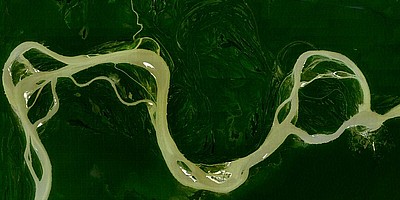Proto-Amazon: Determining the origins and history of the Amazon River.

Millions of years ago the Amazon River and the Amazon watershed were very different than what we know today. The precursor “Proto-Amazon” River may have flowed in the opposite direction from today discharging its water and sediment into the Pacific Ocean. Of course, the main stem of the Amazon River currently flows from west to east, collecting water from across the continent, from the high Andes to the lowland zones of Brazil. The modern originates in the high Andes in the Ucayali-Apurímac river system of Peru and the Napo and Pastaza river systems of Ecuador, and then flows eastward almost directly along the equator on its long journey to the Atlantic Ocean.
If, as hypothesized, the Proto-Amazon River originally flowed westward, its outlet may have been near the modern Gulf of Guayaquil. Dr. Brian Horton, Visiting Professor of Geology at Yachay Tech and permanent Professor of Geology at University of Texas is undertaking new research seeking to discover the existence and pathway of the Proto-Amazon River. If it did exist, the Proto-Amazon may have followed a path across the region currently occupied by a narrow portion of the Andean range, not far north of the current city of Cuenca, Ecuador.
In order to test this hypothesis, Professor Horton will study the provenance of ancient sediments of the Cenozoic era deposited by past Ecuadorian rivers. These sediments may have originated far to the east in the continental interior of Brazil and been transported westward by the Proto-Amazon. His field work will involve collecting samples from ancient sedimentary deposits in the Cuenca region, between Cañar and Nabon, where previous studies identified sediments in the crucial age range of 25 to 5 million years before present. The most important analysis to be undertaken on these samples is analysis of small grains of the mineral, zircon, that will allow determination of the age and approximate source location of these grains.
The uranium-lead (U-Pb) radiometric dating technique provides an understanding of the age and origin of the zircon minerals lodged in the sediment samples. For each sandstone sampled, analyses of approximately 100 individual zircon grains will provide the distribution of radiometric ages accurately representing the original source of the sediments. The important thing (the critical test of the hypothesis) is to determine the presence or absence of zircons with very specific ages and characteristics that would place them in Brazil, the area where the Proto-Amazonas is proposed to have originated.
The most likely cause of such a major continental-scale reversal of the Amazon River is the rise of the Andes. That’s why Ecuador is the perfect place for this study. Whereas the Colombian and Peruvian Andes were established at an earlier stage, it is believed that the Ecuadorian Andes arose later. This part of the mountain range was the last piece to complete the puzzle of the Andes and its emergence changed the geography and possibly the biodiversity of the entire Amazon.
A study of this kind can allow to throw some light on how the current Amazon geography was formed and how it contribute to the expansion of biodiversity in the area. More importantly, it can contribute to understand how tectonic changes have affected the river’s nature and, therefore, its ecosystems. Even more, if we dare, we can try to predict how the current tectónic movements can affect the river, and ecosystems, in the future.
Dr. Horton has a Ph.D. in Geosciences from the University of Arizona. He has research experience working on the Andes and South American rivers. He has won several major awards in his field, including the Donath Medal of the Geological Society of America. He has worked in Bolivia, Argentina, Peru, and Colombia (and many other locations around the world) for many years, but his current work in Ecuador represents a new location for his studies. As Visiting Professor at Yachay Tech, Dr. Horton taught the very first course in our new Geology major in the School of Geological Sciences and Engineering. We expect that his affiliation with Yachay will be a permanent one. Dr. Horton’s research is funded by the National Geographic Society and the US National Science Foundation.